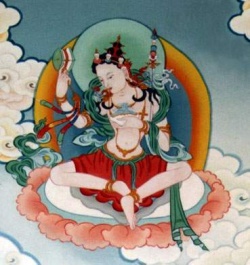Prāna
Prana (प्राण, prāṇa) is the Sanskrit word for "life force"; in yoga, Oriental medicine, and martial arts, the term refers to a cosmic energy believed to come from the sun and connecting the elements of the universe.
The universal principle of energy or force, responsible for the body's life, heat and maintenance, prana is the sum total of all energy that is manifest in the universe.
This life energy, prana (प्राण) has been vividly invoked and described in Vedas. In Ayurveda, tantra and Tibetan medicine "praṇā vāyu" is the basic vāyu (wind, air) from which all the other vāyus arise.
In Yoga, the three main channels of praṇā vāyu are the Ida, the Pingala and the Sushumna.
Ida relates to the right side of the brain, and the left side of the body, terminating at the left nostril and pingala to the left side of the brain and the right side of the body, terminating at the right nostril.
In some practices, alternate nostril breathing balances the praṇā vāyu that flows within the body.
In most ancient texts, the total number of nadis in the human body is stated to be 72,000. When praṇā vāyu enters a period of uplifted, intensified activity, the Yogic tradition refers to it as Pranotthana.
The ancient concept of Prana is described in many early Hindu texts, such as the Upanishads and Vedas.
One of the earliest references to Prana is from the 3,000-year-old Chandogya Upanishad, but many other Upanishads also make use of the concept, including the Katha, Mundaka and Prasna Upanishads.
The concept is elaborated upon in great detail in the practices and literature of haṭha yoga, tantra, and Ayurveda.
Prana is typically divided into multiple constituent parts, in particular when concerned with the human body.
While not all early sources agree on the names or number of these subdivisions, the most common list from the Mahabharata, the Upanishads, Ayurvedic and Yogic sources includes five, often divided into further subcategories.
This list includes:
Prana (inward moving energy), Apana (outward moving energy), Vyana (circulation of energy),
Udana (energy of the head and throat), and Samana (digestion and assimilation).
Early mention of specific pranas often emphasized Prāṇa Apāna and Vyāna as "the three breaths".
This can be seen in the proto-yogic traditions of the Vratyas among others.
Texts like the Vaikānasasmārta utilized the five pranas as an internalization of the five sacrificial fires of a panchagni homa ceremony.
Nadi
Further information: Nadi (yoga)
Indian philosophy describes prana flowing in channels called Nadis.
The Shiva Samhita states that there is a total of 350,000 nadis in the human body, while other texts says there are 72,000 nadis, each branching off into another 72,000.
These nadis play an important role in the application and understanding of certain yoga practices.
Shiva Samhita explains that the three most important nadis are the Ida, the Pingala and the Sushumna, each facilitating the flow of praṇā vāyu throughout the body.
Ida nadi relates to the right side of the brain, and the left side of the body, terminating at the left nostril.
Pingala nadi relates to the left side of the brain and the right side of the body, terminating at the right nostril.
Sushumna nadi connects the base chakra at the base of the spine to the crown chakra at the top of the head.[citation needed]
The practice of pranayama can be used to balance the flow of prana within the body.
When praṇā vāyu enters a period of uplifted, intensified activity, the yogic tradition refers to it as pranotthana, a precursor to the Kundalini state.
Pranayama
article: Pranayama
The word Prāṇāyāma derives from the Sanskrit words prāṇa and ayāma, translating as "life force" and "expansion" respectively.
It is a common term for various techniques for accumulating, expanding and working with prana. In yoga, pranayama is a practise of specific and often intricate breathing techniques.
Many pranayama techniques are designed to cleanse the energetic channels called nadis allowing for greater movement of prana.
Other techniques may be utilized to arrest the breath for samadhi or to bring awareness to specific areas in the practitioner's subtle or physical body.
It can also be utilized to generate inner heat as in the practice of tummo.
In ayurveda and therapeutic yoga pranayama may also be utilized for any number of tasks including to affect mood and aid in digestion.
A.G. Mohan says the physical goals of pranayama may be to recover from illness or the maintenance of health while its mental goals are "to remove mental disturbances and make the mind focused for meditation".
According to Georg Feuerstein "the two most important species of the life force are obviously prâna and apâna, which underlie the breathing process.
Their incessant activity is seen as the principal cause for the restlessness of the mind, and their stoppage is the main purpose of breath control (prânâyâma)".
Swami Yogananda writes that "The real meaning of Pranayama, according to Patanjali's, the founder of Yoga philosophy, is the gradual cessation of breathing, the discontinuance of inhalation and exhalation". See also
| Vāyu | Responsibility |
|---|---|
| Prāṇa | Beating of the heart and breathing. Prana enters the body through the breath and is sent to every cell through the circulatory system. |
| Apāna | elimination of waste products from the body through the lungs and excretory systems |
| Uḍāna | sound production through the vocal apparatus, as in speaking, singing, laughing, and crying. Also it represents the conscious energy required to produce the vocal sounds corresponding to the intent of the being. Hence Samyama on udana gives the higher centers total control over the body. |
| Samāna | the digestion of food and cell metabolism (i.e. the repair and manufacture of new cells and growth). Samana also includes the heat regulating processes of the body. Auras (paranormal) are projections of this current. By meditational practices one can see auras of light around every being. Yogis who do special practises on samana can produce a blazing aura at will. |
| Vyāna | the expansion and contraction processes of the body, e.g. the voluntary muscular system |
Praṇā vāyu is the basic vāyu from which all the other vāyus arise.







